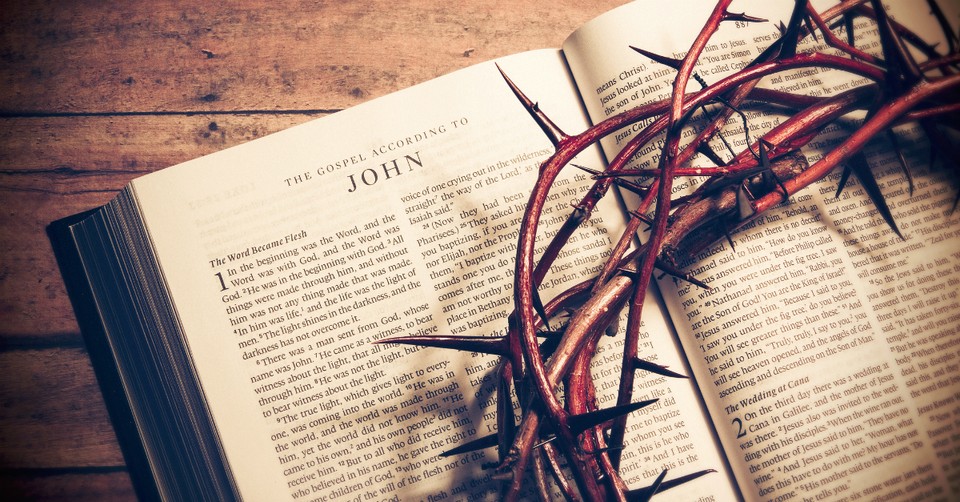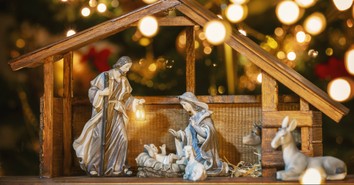What Are the Seven ‘I Am’ Statements of Jesus?

One of the most basic yet profoundly deep names for God is revealed to us in the Bible as “I Am.” God first revealed this name to Moses during their encounter at the burning bush, just before God called Moses to lead the people out of slavery.
Moses, who saw the bush ablaze but not consumed, had been astounded at the sight and crept closer for a better look. God then called Moses by name, identifying Himself as “the God of your father” and, further, “I Am who I Am. This is what you are to say to the Israelites: ‘I am has sent me to you” (Exodus 3:14).
“I Am” is a powerful, mighty name for God, for as we are told in Genesis 1, God is the creator of all—heavens and earth, darkness and light, and in Revelation 1:8, “the Alpha and the Omega … who is, and who was, and who is to come, the Almighty.”
He is all, everything. The world started through Him and is all according to His perfect and good design.
But many people don’t know there are other, parallel “I Am” statements in Scripture, these all spoken by Jesus Christ, the Messiah and the Son of God. Jesus—who is also God, part of the holy trinity that is Father, Son, and Holy Spirit—made seven “I Am” statements in the Gospel of John. Each of these teach us something about the open, loving, accepting, and divine nature of the Lord.
What are the seven “I Am” statements of Jesus? And what do they signify?
What Are the Seven ‘I Am’ Statements of Jesus?
The seven “I Am” statements all appear in the Gospel of John. In each, Jesus proclaims His essence: I am the bread of life (John 6:35), the light of the world (8:12), the gate (10:7), the good shepherd (10:11, 14), the resurrection and the life (11:25), the way and the truth and the life (14:6), and the true vine (15:1).
Each signifies a different aspect of His divine nature, and many of them appear to be tied to a miracle or important teaching moment that had just been offered, perhaps as illumination.
Photo credit: ©Getty Images/Javier Art Photography

1. I Am the Bread of Life
The first “I Am” statement comes in John 6. The day prior, Jesus had just fed 5,000 with five loaves and two fish, then retreated alone to a mountain. Hours later, the disciples witnessed Him walking on water.
The next day the crowd found Jesus on the other side of the lake, where Jesus told them He provides far more than the loaves they’d consumed.
In John 6:35, Jesus declares, “I am the bread of life. Whoever comes to me will never go hungry, and whoever believes in me will never be thirsty.”
It’s an elaboration of what He’d just explained—don’t work so hard for “food that spoils,” a temporary reprieve. Rather, seek the “bread” that offers eternal life. Seek Jesus.
2. I Am the Light of the World
This second “I Am” statement is uttered by Jesus on the last day of the Feast of the Tabernacles, an elaborate Jewish celebration with a number of ceremonies, including those of water and of light.
The deeper meaning behind Jesus’ words was likely not lost on the crowd there, which is perhaps why His statement caused such outrage among those gathered.
“I am the light of the world. Whoever follows me will never walk in darkness, but will have the light of life,” Jesus said (John 8:12), and His words were met with scoffs of challenge and disdain.
“Here you are, appearing as your own witness; your testimony is not valid,” the Pharisees countered in verse 13.
To them, Jesus—standing in the midst of ceremonial lighted bowls of oil and water and among a people who would have viewed His claims as blasphemy or even heresy—was issuing fighting, inflammatory words.
His statement here comes not only in the midst of the festival but just after Jesus’s controversial teachings in the temple, where people began to quarrel over whether He was the Messiah (John 7:25-52) and just after His encounter with the woman caught in adultery, whose stoning He prevented as a teaching moment on sin, condemnation, and judgment.
His proclamation, that He is the light, offers an important word on human judgment versus God’s holy and righteous judgment.
Photo credit: Unsplash/Kate Remmer

3. I Am the Gate
The next “I Am” statement comes in John 10:7 when Jesus told His followers, “I am the gate for the sheep.”
The sheep’s gate was an important concept for people of that day. Sheep were cared for by a shepherd. They trusted their shepherd, knew his voice intimately, and understood he loved them and would protect them. When the sheep would come in for the night, they would enter their protective enclosure, or sheep’s pen, by way of this gate.
Jesus then went on to elaborate that, as the gate, “Whoever enters through me will be saved. They will come in and go out, and find pasture. … I have come that they may have life, and have it to the full” (v. 9-10).
His statement comes just after Jesus had healed a man born blind and received much criticism from the Pharisees because He did so on the Sabbath, leading to a heated discussion between Jesus and some church leaders on spiritual blindness.
Jesus’s statement that He is the gate—the door, the way, the opening between two separate areas—is like an illumination of His healing of the man, who went from blindness to sight, whether physical or spiritual or both.
4. I Am the Good Shepherd
Jesus’s next “I Am” statement immediately follows His claim to be the gate.
“I am the good shepherd. The good shepherd lays down his life for the sheep,” Jesus says in John 10:11, and adds, a few lines later, “I am the good shepherd; I know my sheep and my sheep know me— just as the Father knows me and I know the Father—and I lay down my life for the sheep” (v. 14-15).
For not only is Jesus the gate, or entryway, to this new, full, and abundant life, but He is also the shepherd who cares for the sheep and herds them toward this life. He is both the caregiver and the place by which they receive that care—the person and the place in one.
Indeed, He loves the sheep so much He not only knows the sheep and is known by the sheep, but He also leads them to where they need to be and further protects them from harm in the most loving of ways—even laying down His own life for the sheep.
Photo credit: Unsplash/nknezevic

5. I Am the Resurrection and the Life
Jesus’s next “I Am” statement is a bold one. Arriving just after His dear friend Lazarus has died, Jesus meets Martha, Lazarus’s sister, who is in desperate grief over the loss of her brother. Her words are both accusation and truth: My brother wouldn’t have died if you’d been here (John 11:21).
When Jesus told her Lazarus would rise again, her grief is almost palpable. Sure, she replies—he will one day, at the resurrection.
This is when Jesus delivers His zinger: “I am the resurrection and the life. The one who believes in me will live, even though they die; and whoever lives by believing in me will never die” (John 11:25-26).
Then, as if to drive His point home, Jesus embodies that resurrection, raising Lazarus from the dead back to his earthly life.
Indeed, He is the resurrection and the life—both of the earth and the spirit.
6. I Am the Way and the Truth and the Life
At the Last Supper, in the hours just before His arrest, Jesus spends intimate time with His disciples, teaching them numerous lessons about love, service, and the gift that is to come in the Holy Spirit.
But when Jesus explains He’s about to go prepare a place for His friends in the Father’s house—that is, the Kingdom of Heaven—and that they’ll know the way, Thomas stops Jesus.
What do you mean? Thomas asks. How would we know the way?
That’s when Jesus utters His sixth “I Am” statement: “I am the way and the truth and the life. No one comes to the Father except through me” (John 14:6).
Just as Jesus is the light, the gate, the bread, and more, He’s also the way. He’s the path the disciples are to take to get to their destination: eternal salvation. In their intimate relationship with Him, they have unlocked the mystery, that special path to access the truth and the life.
Photo credit: ©Getty Images/alessandrophoto

7. I Am the Vine
Jesus hammers this point with His last “I Am” statement: “I am the true vine, and my Father is the gardener” (John 15:1), then notes the disciples are His branches.
A few lines later, Jesus warns, “Apart from me you can do nothing. If you do not remain in me, you are like a branch that is thrown away and withers; such branches are picked up, thrown into the fire and burned. If you remain in me and my words remain in you, ask whatever you wish, and it will be done for you” (John 15:5b-7).
The metaphor of the vine, the gardener, and the branches would have been clear to any Israelite of that day and time, both because they lived and worked with or near grapevines and also, as part of Jewish culture, because they would have been accustomed to the vine as a symbol of Israel, an old and holy image.
When Jesus said He was the “true vine,” and that the disciples were to remain in Him, this was an illustration of how the disciples, and anyone else who followed Him, could get back on track. By nourishing themselves only through Jesus, they were getting their strength from the true source of life, God Himself, Word become flesh and born a man (John 1).
In Genesis, God told Abraham “I am God Almighty.” In Exodus, God told Moses “I Am who I Am.”
Throughout Scripture God shows us His nature through words and actions. He is God the Almighty and God the Most High, God Who Sees and God With Us.
He is love and goodness and power and might all rolled into one.
In His seven “I Am” statements, Jesus is saying the same things. As the Son of God, Jesus is Word become flesh (John 1:14). He offers eternal life, sacrificial love, and our direct pathway to heaven, and He is the true light in the midst of all the darkness.
He is Lord, and through Him, we are saved.
More from this author
Do We Still Need to Honor the Sabbath?
Is It Ok to Question God?
What Is God's "Secret Plan"?
Photo credit: Pexels/Tim Mossholder
Originally published March 21, 2022.









